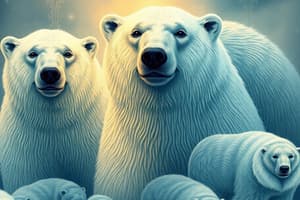Podcast
Questions and Answers
Animals and plants adapt to their environment in the same way that humans do.
Animals and plants adapt to their environment in the same way that humans do.
False (B)
Why can humans adapt to their environment faster than animals and plants?
Why can humans adapt to their environment faster than animals and plants?
- Because they have thicker fur.
- Because they live in warmer climates.
- Because they can change their surrounding environment. (correct)
- Because they can depend on the adaptation of their traits only.
In what zone is the weather very cold?
In what zone is the weather very cold?
Arctic zone
Animals in the Arctic zone wear heavy clothes to protect themselves from the cold weather.
Animals in the Arctic zone wear heavy clothes to protect themselves from the cold weather.
What is an example of a trait that helps the polar bear to survive?
What is an example of a trait that helps the polar bear to survive?
The polar bear has layers of fat and ______ to keep it warm.
The polar bear has layers of fat and ______ to keep it warm.
What does white fur help the polar bear do?
What does white fur help the polar bear do?
What is blubber?
What is blubber?
Flashcards
Animal Adaptation (Timeframe)
Animal Adaptation (Timeframe)
A slow process of adjustment to the environment that can take hundreds or thousands of years in animals and plants.
Arctic Zone
Arctic Zone
The Arctic is a geographic region located at the northernmost part of the Earth.
Blubber
Blubber
Thick fat layer with many blood vessels that helps maintain body temperature in cold environments.
Adaptation Traits
Adaptation Traits
Signup and view all the flashcards
Camouflage
Camouflage
Signup and view all the flashcards
White Fur (Arctic Adaptation)
White Fur (Arctic Adaptation)
Signup and view all the flashcards
Body Vibration (Thermoregulation)
Body Vibration (Thermoregulation)
Signup and view all the flashcards
Feather Fluffing
Feather Fluffing
Signup and view all the flashcards
Environmental Adaptation
Environmental Adaptation
Signup and view all the flashcards
Blood Vessels in Blubber
Blood Vessels in Blubber
Signup and view all the flashcards
Blubber Composition
Blubber Composition
Signup and view all the flashcards
Trait Dependence
Trait Dependence
Signup and view all the flashcards
Natural Selection
Natural Selection
Signup and view all the flashcards
Thermoregulation by Vibration
Thermoregulation by Vibration
Signup and view all the flashcards
Warming Muscles
Warming Muscles
Signup and view all the flashcards
Insulation of Fur
Insulation of Fur
Signup and view all the flashcards
Camouflage Example
Camouflage Example
Signup and view all the flashcards
Class Discussion
Class Discussion
Signup and view all the flashcards
Keeping animals warm
Keeping animals warm
Signup and view all the flashcards
Polar bear Survival
Polar bear Survival
Signup and view all the flashcards
Study Notes
- Adaptation in animals is a slow process.
- Animal adaptation can take hundreds or thousands of years.
- Humans adapt faster than animals and plants.
- Humans can change their surrounding environment, unlike animals and plants.
- In the Arctic zone, the weather is very cold.
- Animals in the Arctic cannot wear heavy clothes.
- Animals in the Arctic depend on their traits to avoid the cold.
- Polar bears have thick white fur to help them survive.
- Polar bears have layers of fat and blubber to keep warm.
- Blubber is thick fat with many blood vessels.
- White fur helps polar bears blend with the snow.
- Blending with the snow helps conceal themselves from prey.
- Arctic animals vibrate their bodies to keep their muscles warm.
- Arctic birds fluff their feathers to trap warm air near their bodies.
Studying That Suits You
Use AI to generate personalized quizzes and flashcards to suit your learning preferences.




